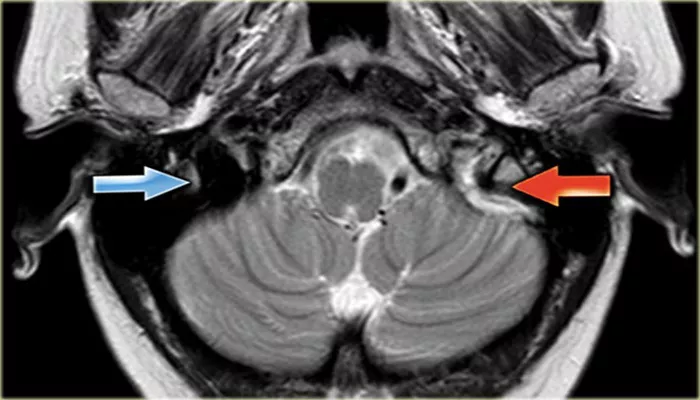Bilateral transverse sinus stenosis (BTSS) is a condition characterized by the narrowing of the transverse sinuses, which are critical components of the brain’s venous drainage system. This condition has garnered attention due to its association with various neurological disorders, particularly idiopathic intracranial hypertension (IIH).
Understanding the causes of BTSS is essential for effective diagnosis and treatment. This article explores the primary causes of bilateral transverse sinus stenosis, including anatomical factors, pathological conditions, and potential risk factors.
Introduction
The transverse sinuses are large veins located at the back of the skull that drain blood from the brain. When these sinuses become narrowed or stenotic, it can lead to increased intracranial pressure and a range of neurological symptoms. BTSS is often detected through imaging studies such as magnetic resonance venography (MRV) or computed tomography (CT) venography. The presence of BTSS has been linked to conditions like IIH, which is characterized by elevated cerebrospinal fluid (CSF) pressure without an identifiable cause.
The relationship between BTSS and IIH is complex. Some studies suggest that BTSS may be a primary cause of IIH, while others propose that elevated intracranial pressure leads to secondary changes in venous drainage. This article will delve into the various causes of BTSS, providing a comprehensive overview for clinicians and researchers alike.
SEE ALSO: Does Sinus Headache Cause High Blood Pressure?
Anatomical Factors
1. Congenital Anomalies
Congenital anomalies can significantly contribute to the development of BTSS. Some individuals may be born with anatomical variations that predispose them to venous stenosis. For instance, hypoplasia (underdevelopment) of the transverse sinuses can lead to inadequate venous drainage from the brain. This anatomical insufficiency may not only cause BTSS but also contribute to increased intracranial pressure over time.
2. Variations in Venous Drainage Patterns
The human vascular system exhibits considerable variability among individuals. Variations in venous drainage patterns can lead to compensatory mechanisms that may result in increased pressure within certain sinuses. For example, if one transverse sinus is significantly smaller than its counterpart, it may become overloaded, leading to stenosis in both sinuses due to altered hemodynamics.
Pathological Conditions
1. Idiopathic Intracranial Hypertension (IIH)
IIH is one of the most common associations with BTSS. In patients with IIH, studies have shown that up to 94% exhibit bilateral transverse sinus stenosis on MRV imaging3. The exact mechanism linking IIH and BTSS remains debated. Some researchers argue that elevated CSF pressure causes structural changes in the transverse sinuses, leading to stenosis. Others suggest that pre-existing stenosis may predispose individuals to develop IIH by impairing venous outflow.
2. Venous Sinus Thrombosis
Venous sinus thrombosis (VST) occurs when a blood clot forms in the dural sinuses, obstructing normal blood flow. This condition can lead to increased intracranial pressure and may result in secondary changes such as BTSS. In cases where VST is bilateral, it can exacerbate symptoms associated with elevated intracranial pressure.
3. Chiari Malformation
Chiari malformation is a structural defect in the brain where brain tissue extends into the spinal canal. This condition has been linked with various cerebrospinal fluid dynamics abnormalities and may contribute to BTSS by altering normal venous drainage patterns6. The presence of Chiari malformation can complicate the clinical picture, making it essential for clinicians to consider this condition when evaluating patients for BTSS.
Risk Factors
1. Obesity
Obesity is a significant risk factor for developing IIH and subsequently BTSS. Increased body mass index (BMI) has been correlated with higher CSF pressures, which can lead to changes in venous drainage dynamics and contribute to stenosis2.
The prevalence of obesity-related IIH highlights the importance of weight management as a preventive measure against BTSS.
2. Hormonal Factors
Hormonal changes can influence intracranial pressure and venous drainage patterns. Women are disproportionately affected by IIH and BTSS, particularly during periods of hormonal fluctuation such as pregnancy or menstruation1. The role of hormones in modulating vascular tone and fluid balance suggests that they may play a part in the development of these conditions.
3. Systemic Conditions
Certain systemic conditions such as hypertension and connective tissue disorders can predispose individuals to develop BTSS. Hypertension can lead to increased vascular resistance and altered hemodynamics within the cranial venous system, potentially resulting in stenosis over time4. Similarly, connective tissue disorders may affect vascular integrity and contribute to abnormal venous drainage patterns.
Clinical Implications
Understanding the causes of bilateral transverse sinus stenosis is crucial for effective diagnosis and treatment planning.
Clinicians should consider a comprehensive approach when evaluating patients with suspected BTSS or related symptoms:
Imaging Studies: Utilize MRV or CT venography to assess for signs of stenosis.
Lumbar Puncture: Measure CSF pressure when IIH is suspected; elevated pressures may indicate a direct link between IIH and BTSS.
Multidisciplinary Approach: Collaborate with neurologists, radiologists, and other specialists to address underlying conditions contributing to BTSS.
Conclusion
Bilateral transverse sinus stenosis is a multifactorial condition influenced by anatomical variations, pathological processes like idiopathic intracranial hypertension, and various risk factors including obesity and hormonal changes. A thorough understanding of these causes allows healthcare professionals to better diagnose and manage patients with this condition effectively.
Related topics:


